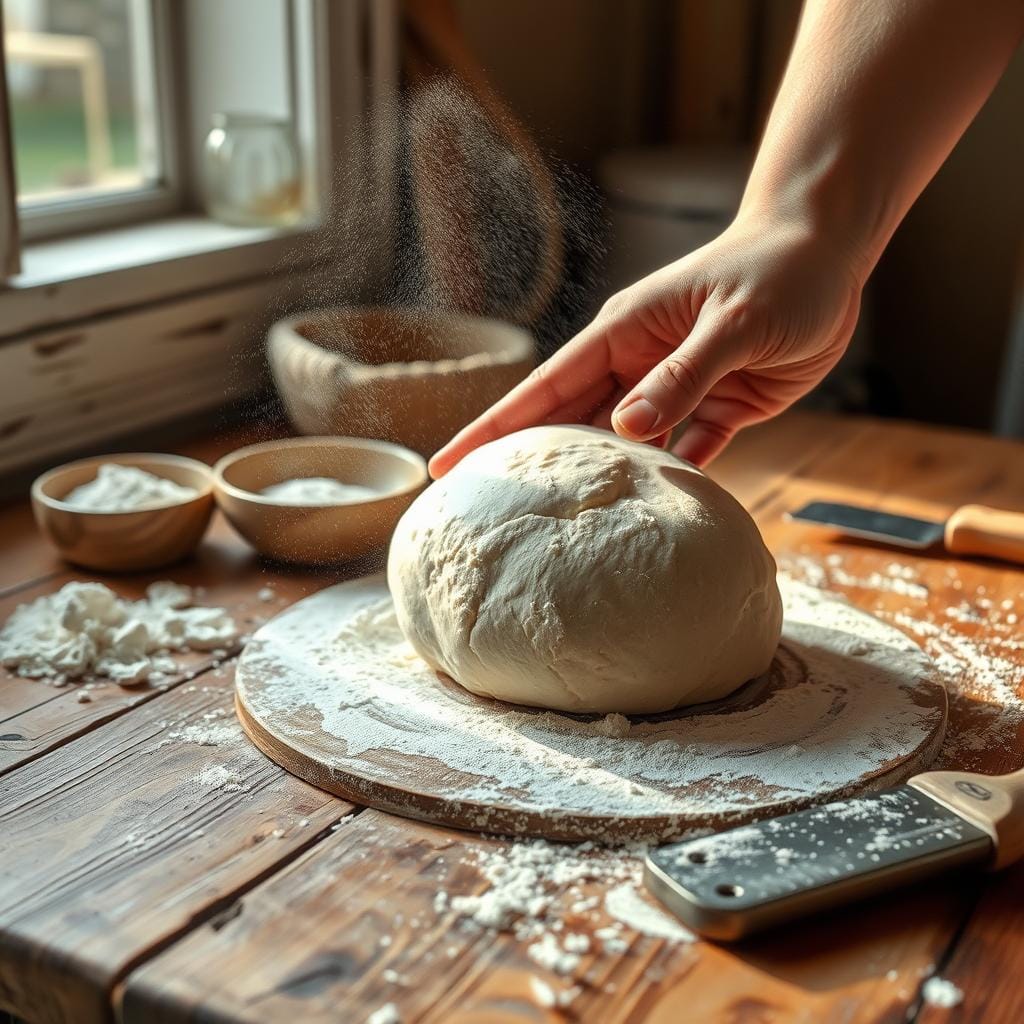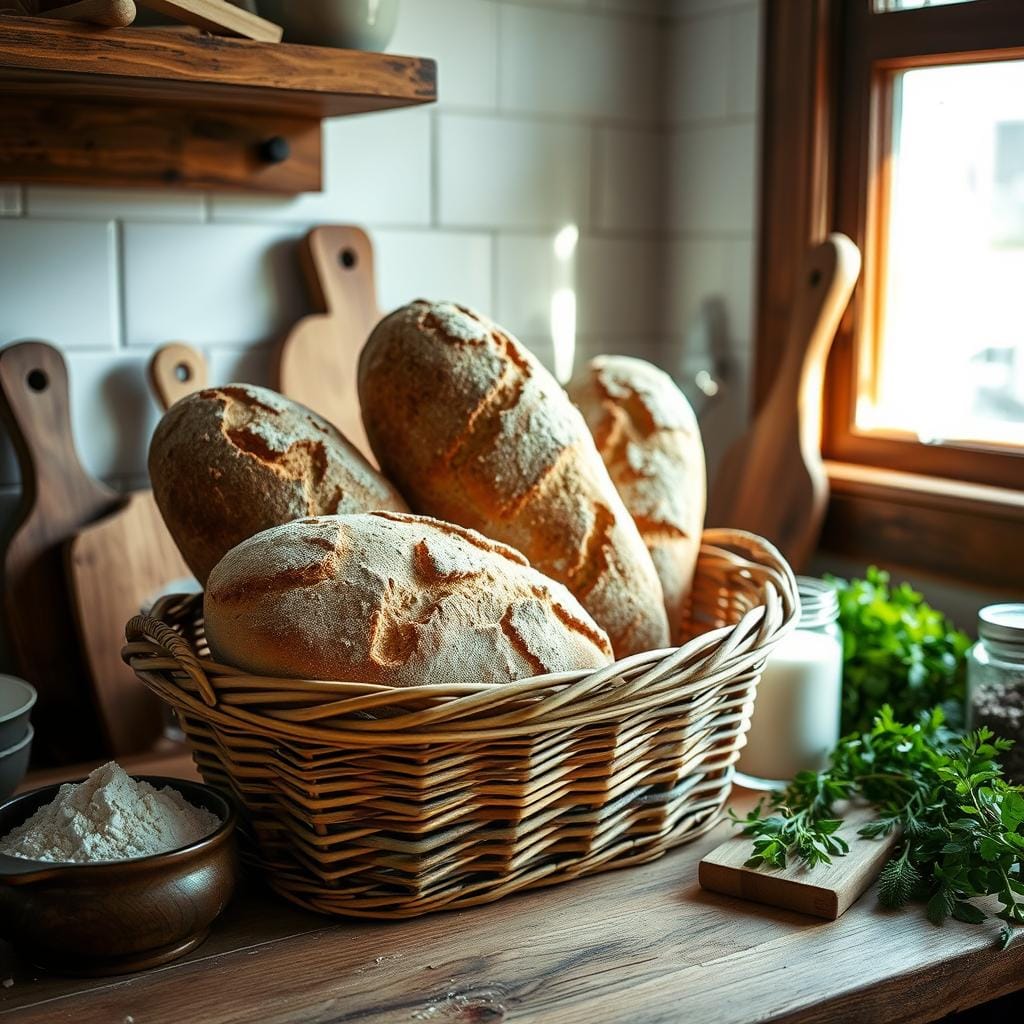As I knead the dough, the smell of fermented wheat fills the air. It reminds me of my grandmother’s kitchen. Her sourdough sandwich bread was a family favorite, known for its soft crumb and tangy taste. Now, I’m excited to share this recipe with you, the ultimate sourdough bread.
Baking bread is a personal and rewarding experience. This sourdough sandwich bread recipe is no different. It requires patience and a slow fermentation process to create a remarkable loaf. Whether you’re new to bread baking or experienced, this recipe will help you make a soft, fluffy, and flavorful sourdough sandwich bread. It will take your meals to the next level.
Key Takeaways
- Soft and fluffy sourdough sandwich bread with a tangy flavor
- Made with all-natural ingredients, including an active sourdough starter
- Lengthy fermentation process for enhanced flavor and texture
- Versatile for sandwiches, toast, and a variety of culinary uses
- Easy-to-follow recipe suitable for both novice and experienced bakers
Introduction to Sourdough Sandwich Bread
Get ready to enjoy the soft, fluffy sourdough sandwich bread. It has a tangy taste from the fermented dough. This makes it great for sandwiches, toast, and more. Unlike dense sourdough, this bread is light and airy, perfect for daily use.
Soft and Fluffy Texture with a Tangy Flavor
The secret to this bread is the fermentation. Wild yeasts and bacteria in the starter make the dough soft and tasty. The slow fermentation improves the bread’s taste and makes it easier to digest, making it a healthier option.
Perfect for Sandwiches and Toast
This sourdough sandwich bread is ideal for fillings and toppings. It’s great for grilled cheese, lunchmeats, or toast with coffee. It offers a soft yet sturdy base for your favorite dishes.
| Sourdough Sandwich Bread Statistics |
|
|---|---|
| Tangzhong Ingredients |
|
| Dough Ingredients |
|
| Levain Ingredients |
|
Sourdough bread is a staple in my weekly routine, and this recipe eliminates the need to purchase bread. The soft, fluffy texture and tangy flavor make it perfect for sandwiches, toast, and more.”
Benefits of Homemade Sourdough Bread
Making sourdough bread at home has many perks. You only need a few, top-notch ingredients like flour, water, salt, and sourdough starter. No preservatives or additives are used, unlike in store-bought bread.
Sourdough bread uses natural yeast from the starter, not commercial yeast. This makes the bread better for you. It can increase mineral absorption by up to 70%. Plus, it has a lower glycemic index than regular bread, helping control blood sugar.
The process of making sourdough is also fulfilling. It involves mixing, kneading, shaping, and baking. This hands-on approach connects you to the art of bread making. Homemade sourdough is tasty and healthier than store-bought bread.
- Minimal, high-quality ingredients without preservatives or additives
- Natural fermentation process deactivates phytic acid and lowers glycemic index
- Sensory and meditative experience of the sourdough baking process
- Healthier and more rewarding option compared to store-bought bread
“Homemade sourdough bread is not only delicious, but also a healthier and more rewarding option compared to mass-produced loaves.
Understanding Sourdough Starter
The sourdough starter is at the heart of every delicious sourdough sandwich bread. It’s a mix of wild yeast and good bacteria that makes the bread soft and fluffy. Unlike regular yeast, a sourdough starter is made from flour and water that’s been fermented for a long time. This process creates a community of microorganisms that turn dough into a beautifully risen loaf.
Natural Yeast for Leavening Dough
Sourdough starters are key to making bread light and airy without commercial yeast. The wild yeast in the starter eats the sugars in the flour, creating carbon dioxide bubbles. This makes the dough rise and gives sourdough bread its tangy flavor.
Creating Your Own Sourdough Starter
- Start with a mix of equal parts flour and water, like 50g each.
- Let the mix sit at room temperature for 24 hours. Then, throw away half and feed the rest with another 50g each of flour and water.
- Keep feeding it daily for 5-7 days. Your starter will get bubbly, active, and double in size after each feeding.
- When your starter is ready, you can use it to make all sorts of tasty sourdough breads, like sandwich loaves or crisp boules.
With a bit of patience and practice, you can make your own sourdough starter. It will be the base for baking amazing homemade breads over and over again.
Essential Tools for Sourdough Baking
Making perfect sourdough sandwich bread at home needs a few key tools. Having these tools makes baking sourdough easier and more fun.
A stand mixer with a dough hook is a big help for kneading. If you don’t have one, you can still mix and knead by hand. A Danish dough whisk is great for mixing all the ingredients at the start.
A metal bench scraper is very useful. It’s good for shaping dough, cutting it, and cleaning your work area. Don’t forget a 9″ x 5″ loaf pan for baking your bread.
| Tool | Purpose | Recommended Product | Average Price |
|---|---|---|---|
| Digital Scale | Accurately measure ingredients | GDEALER Digital Food Scale | $10 |
| Dough Proofing Container | Monitor dough rise | Cambro 4-qt Container | $15 |
| Flour Sack Towels | Handle high-hydration dough | Flour Sack Kitchen Towels | $10 for 4-pack |
| Parchment Paper | Easy transfer to Dutch oven | Reynolds Parchment Paper | $3 for 60 sq ft |
| Dough Lame | Score dough before baking | PBBOA Lame Bread Scoring Tool | $8 |
| Dutch Oven | Achieve a crusty boule | Lodge Double Dutch Oven | $70 |
| Oven Mitts | Handle hot cast iron vessels | OXO Good Grips Silicone Oven Mitts | $25 |
| Bread Knife | Cut crusty loaves | Mercer Culinary Bread Knife | $20 |
With these tools, you’re ready to make delicious sourdough sandwich bread at home. Enjoy baking!
Sourdough Sandwich Bread Recipe
Make a delicious, soft sourdough sandwich bread at home with this simple recipe. It’s all about using top-notch ingredients and waiting patiently for the dough to ferment. You’ll love the amazing smell and feel of homemade sourdough bread.
Enjoy your homemade Hoagie sandwich bread! This recipe makes 2 loaves of soft, tangy bread. It’s perfect for sandwiches, toast, and more.
Shaping and Proofing the Dough
After the dough’s first long fermentation, it’s time to shape and proof the loaf. This step is key for a perfect bread structure and rise. Let’s explore how to shape sourdough bread and why proofing is so important.
Folding and Shaping Techniques
Begin by turning the dough onto a lightly floured surface. Press it into a rectangle and fold the sides to the center. Roll it up into a tight log, sealing the seam.
This method creates tension in the dough, leading to a beautifully shaped loaf. Place the dough seam-side down in a greased loaf pan. Avoid over-handling to keep the air pockets intact.
Proofing Times and Temperatures
- Let the dough proof at room temperature for 2-3 hours, depending on your kitchen’s temperature. It should rise by about 50%.
- Adjust proofing time based on temperature. Longer at cooler temps, shorter at warmer. Watch the rise and stop when it reaches the pan’s top.
- A well-proofed dough will slowly spring back when poked. It won’t quickly spring back or leave a deep dent.
Proper shaping and proofing are crucial for a soft, fluffy sourdough sandwich bread. With practice, you’ll master these techniques!

Baking the Sourdough Sandwich Bread
Baking the perfect cheese sandwich bread is key. It needs the right oven temperature and baking time. This ensures it’s soft, fluffy, and tangy.
Oven Temperature and Baking Duration
First, preheat your oven to 450°F (232°C). Then, lower it to 375°F (190°C) once you put the bread in. This method makes the crust crisp and the inside even.
The bread should bake for 45-50 minutes. It should turn a deep golden brown by then.
To make the crust even better, try creating steam. Place a few ice cubes at the bottom of the oven. This makes the bread’s exterior crisp and shiny.
| Ingredient | Quantity |
|---|---|
| Bread Flour | 400 grams |
| All-Purpose Flour | 100 grams |
| Baking Temperature | 375°F (190°C) |
| Baking Time | 40-50 minutes |
Following the right baking temperature and time is essential. It makes the sourdough bread soft, fluffy, and tangy. With the right oven time, you’ll get a delicious sourdough bread.
Serving and Storing Sourdough Bread
Once your homemade sourdough sandwich bread cools, it’s ready to be sliced and enjoyed. Its soft crumb and crisp crust are perfect for sandwiches or toast. You can also enjoy it with butter or your favorite toppings.
The tangy flavor and satisfying texture will impress everyone. It’s a treat for your family and friends.
Slicing and Enjoying Fresh Bread
To slice the sourdough bread, use a sharp, serrated knife. Cut gently in a sawing motion. This way, you avoid squishing the soft inside.
Enjoy the bread fresh or add your favorite toppings for a tasty sandwich or open-faced delight.
Storage Tips for Longevity
- Store the sourdough bread in an airtight container or resealable bag at room temperature for up to 3 days.
- For longer-term storage, slice the bread and freeze the individual slices. The frozen slices can be reheated in a toaster or oven when you’re ready to enjoy them, preserving the fresh-baked flavor and texture.
- Properly storing sourdough bread will ensure you can savor its deliciousness for days to come.

By following these simple tips, you can enjoy your homemade sourdough sandwich bread for longer. Savor every bite and share it with your loved ones.
Troubleshooting and FAQs
Making the perfect sourdough sandwich bread is rewarding but can be tricky. You might face issues like texture problems, uneven rise, or poor quality. But don’t worry, with some troubleshooting and understanding of sourdough science, you can fix these problems. This way, you’ll make soft, fluffy sourdough bread every time.
Addressing Common Sourdough Bread Troubles
A common issue is a gummy, dense crumb. This often happens if your sourdough starter is weak or if the dough doesn’t ferment enough. To solve this, keep your starter active and strong. Also, let the dough ferment and proof for longer to develop its structure.
Another problem is a loaf that looks like a cone. This usually means the dough didn’t ferment enough. Make sure your dough has enough time to rise and develop gluten. This will help it have a round shape.
Wet or moist bread inside? This might be because you cut into it too soon. Sourdough needs up to 24 hours to cool and get its texture right. So, wait patiently before slicing.
| Common Sourdough Bread Issues | Potential Causes |
|---|---|
| Gummy, dense crumb | Inactive or weak sourdough starter, under-fermentation |
| Unusual cone shape | Under-fermentation |
| Wet or moist interior | Cutting into the loaf too soon |
| Dough deflates after scoring | Over-fermentation or over-proofing |
| Uneven crumb | Under-fermentation or immature starter |
| Dough spreads when baked | Under or over-fermentation, poor shaping technique |
| Tunnels or large holes in the crumb | Under-fermentation, excess flour during shaping |
| No oven spring | Over or under-fermentation, shaping issues |
| Cooked sourdough | Insufficient baking time |
Knowing these common sourdough bread problems and their causes helps you fix them. This way, you can make the soft, tangy sandwich loaf you dream of. Remember, sourdough baking is all about learning and experimenting. Enjoy the journey and the delicious results.
Variations and Flavor Combinations
This soft sourdough sandwich bread is tasty on its own. But, you can make it even better by adding different mix-ins. Try raisins and cinnamon for sweetness or roasted garlic and herbs for a savory twist. The options are endless.
Sweet Sourdough Bread Combinations
For a sweet touch, add raisins, dried cranberries, cinnamon, or nutella. Just remember, keep the sugar content around 4-6% of the flour. This keeps the bread’s flavor balanced.
- Raisin and Cinnamon Sourdough
- Cranberry Orange Sourdough
- Chocolate Chip and Nutella Swirl Sourdough
Savory Sourdough Bread Variations
For a savory flavor, try herbs, cheese, and roasted garlic. These ingredients can make a classic loaf special. Remember to adjust the dough’s water if using moist ingredients. Lamination helps mix-ins spread evenly.
- Rosemary and Garlic Sourdough
- Cheddar and Caramelized Onion “Pierogi Loaf”
- Pepperoni and Mozzarella Sourdough
Sourdough bread is very versatile. It lets you mix and match flavors to your liking. With a bit of creativity, you can make loaves that are both unique and delicious. Share them with your loved ones.
Conclusion
Making your own soft, fluffy homemade sourdough bread at home is a fun and tasty journey. With just a few simple ingredients and some patience, you can make an artisan-quality sourdough sandwich bread. It’s perfect for sandwiches, toast, and more. The sourdough starter’s natural fermentation gives the bread a tangy flavor and a soft, airy texture.
Mastering this sourdough baking recipe means you’ll have a homemade sourdough bread that everyone will love. The key to success is knowing how the sourdough starter works, shaping and proofing the dough right, and baking it to perfection. With a few tried-and-true techniques, you can make a bakery-quality loaf in your own kitchen.
Whether you’re an experienced baker or new to sourdough baking, this recipe will become a favorite in your kitchen. Embrace the art of homemade sourdough bread and enjoy the joy of making something special and delicious.

Sourdough Sandwich Bread
Craving the perfect sourdough sandwich bread? This recipe delivers a soft, slightly tangy loaf, ideal for read above also Tangzhong sourdough sandwiches, whether it’s a PB&J or a turkey sandwich. Simple to make, with a little patience, you’ll have an irresistible homemade loaf that elevates any meal!
Ingredients
- – 1 cup active sourdough starter
- – 1 cup warm water
- – 3 cups all-purpose flour
- – 2 tbsp sugar
- – 1 1/2 tsp salt
- – 2 tbsp melted butter
Instructions
- Mix the TangzhongWhisk whole wheat flour and whole milk in a saucepan. Cook over medium heat until thickened, about 2 minutes.
- Make the DoughIn a large bowl, combine bread flour, whole wheat flour, olive oil, honey, water, salt, sourdough starter, and the cooled tangzhong. Mix until a dough forms.
- Knead the DoughTurn the dough out onto a lightly floured surface and knead for 5-7 minutes until smooth and elastic.
- First RisePlace the dough in a greased bowl, cover with plastic wrap, and let rise at room temperature for 12-14 hours, or until doubled in size.
- Shape the DoughPunch down the dough and divide it into two equal pieces. Shape each piece into a loaf and place in two greased 9×5-inch loaf pans.
- Second RiseCover the loaves with plastic wrap and let rise at room temperature for 2-3 hours, or until almost doubled in size.
- Preheat the OvenPreheat oven to 450°F (232°C).
- Bake the BreadPlace the loaves in the oven and immediately lower the temperature to 375°F (190°C). Bake for 45-50 minutes, or until golden brown and crusty.
- Cool the BreadRemove the loaves from the oven and let cool on a wire rack for at least 1 hour before slicing and serving.
Nutrition Information:
Yield: 6 Serving Size: 1Amount Per Serving: Calories: 350Total Fat: 5gSaturated Fat: 3gTrans Fat: 0gUnsaturated Fat: 2gCholesterol: 10mgSodium: 616mgCarbohydrates: 67gFiber: 3gSugar: 4gProtein: 9g
FAQ
What are the main ingredients in this soft sourdough sandwich bread recipe?
The main ingredients are all-purpose flour, water, and an active sourdough starter. You also need olive oil, honey, and salt.
How long does the dough need to ferment?
The dough needs to ferment for 10-12 hours. This time is crucial for developing the sourdough’s natural leavening and tangy flavor.
What tools are recommended for making this sourdough bread?
You’ll need a stand mixer with a dough hook, a Danish dough whisk, and a metal bench scraper. Also, a 9″ x 5″ loaf pan is essential.
How do you shape the dough before baking?
First, press the dough into a rectangle. Then, fold it into a log shape. Place it seam-side down in a greased loaf pan for the final proof.
What’s the baking process for this soft sourdough sandwich bread?
Bake the bread at 450°F first. Then, lower the temperature to 375°F for 45-50 minutes. This will make the crust golden brown.
How should the baked sourdough bread be stored?
Store the bread in an airtight container or bag at room temperature for up to 3 days. For longer storage, slice the bread and freeze it for up to 2 months.
What are some potential issues that bakers may encounter?
Issues include an inactive sourdough starter and improper rising times due to kitchen temperature. Overproofing the dough is another common problem.
How can the flavor of this sourdough sandwich bread be customized?
You can add sweetness with raisins, dried cranberries, or cinnamon. For a savory twist, try herbs, cheese, or roasted garlic.





